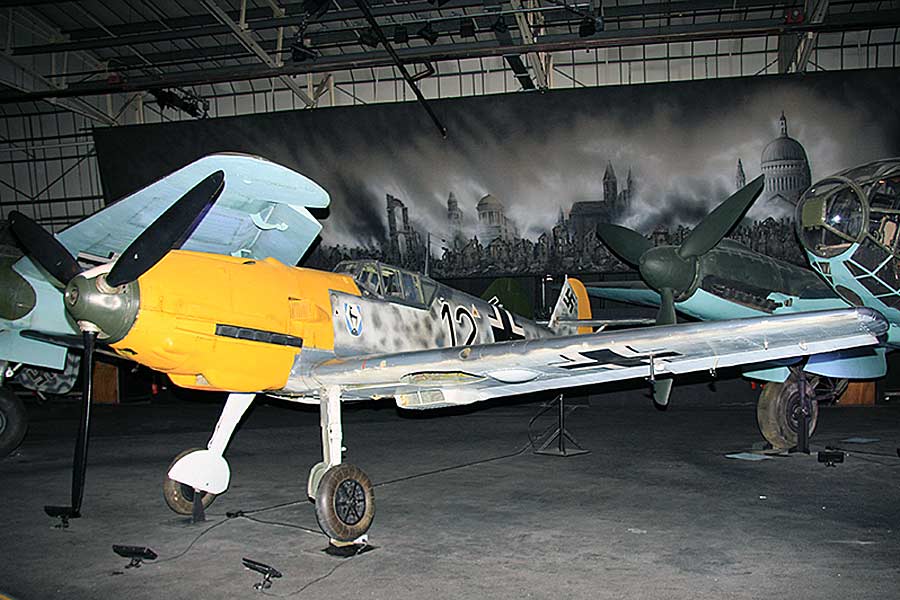
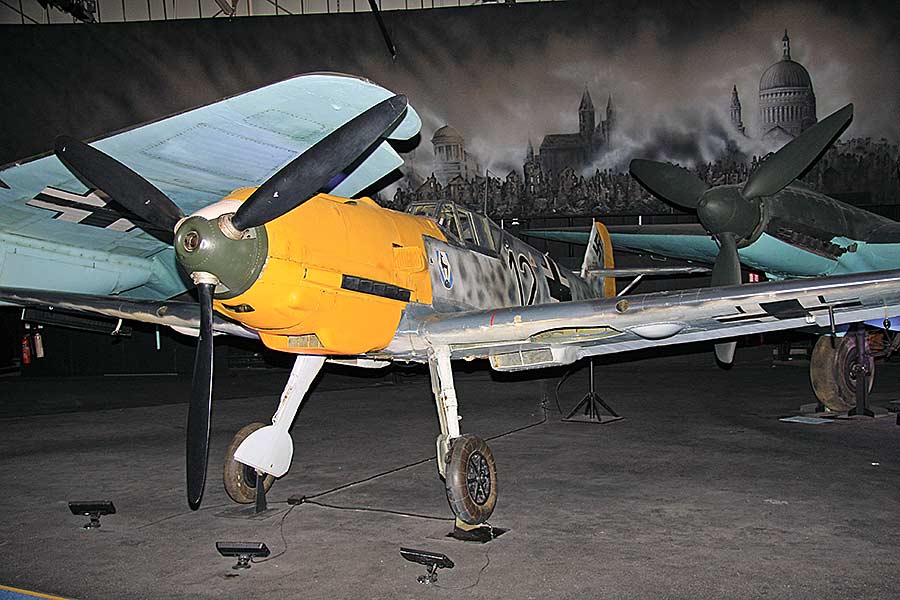


Messerschmitt Bf 109 E4 (4101/DG200) [@ RAF Hendon]
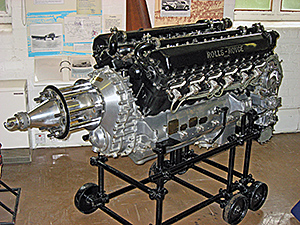 Development of Willi Messerschmitt's
famous Bf 109 began in 1933, when the Reichsluftministerium (RLM) issued
a requirement for a new monoplane fighter. The prototype
Bf 109 V1 flew for the first time in September 1935; powered by a 695 hp
Rolls Royce Kestrel engine [photograph - right], as the 610 hp Junkers Jumo
210A that was intended for it was not yet available. The Bf 109A "Anton"
was the first version of the Bf 109. 22 aircraft were ordered and
delivered with the V4 as the A-series prototype. The Bf 109 V7, armed with two machine
guns and a single MG FF (20 mm (0.79 in) Oerlikon cannon), became the prototype
for the first series production model, the Bf 109 B
"Bruno"
powered by a 610hp Jumo 210 engine driving a two-bladed fixed-pitch propeller. Three of the Bf 109 prototypes were
evaluated in Spain in February and March 1937. Following on was the
Bf 109
B2, with a variable pitch propeller, which immediately proved superior to any other fighter engaged in the
civil war. It was the use of the Bf 109 in Spain that enabled the Luftwaffe to
develop the fighter tactics that would enable it to wreak havoc among its
opponents in the early years of World War II.
Development of Willi Messerschmitt's
famous Bf 109 began in 1933, when the Reichsluftministerium (RLM) issued
a requirement for a new monoplane fighter. The prototype
Bf 109 V1 flew for the first time in September 1935; powered by a 695 hp
Rolls Royce Kestrel engine [photograph - right], as the 610 hp Junkers Jumo
210A that was intended for it was not yet available. The Bf 109A "Anton"
was the first version of the Bf 109. 22 aircraft were ordered and
delivered with the V4 as the A-series prototype. The Bf 109 V7, armed with two machine
guns and a single MG FF (20 mm (0.79 in) Oerlikon cannon), became the prototype
for the first series production model, the Bf 109 B
"Bruno"
powered by a 610hp Jumo 210 engine driving a two-bladed fixed-pitch propeller. Three of the Bf 109 prototypes were
evaluated in Spain in February and March 1937. Following on was the
Bf 109
B2, with a variable pitch propeller, which immediately proved superior to any other fighter engaged in the
civil war. It was the use of the Bf 109 in Spain that enabled the Luftwaffe to
develop the fighter tactics that would enable it to wreak havoc among its
opponents in the early years of World War II.
Completed by Erla Maschinenwerk at Leipzig in September 1940, Werknummer 4101, "black 12” of 2/JG 51, based at Wissant near Calais was a casualty in the Battle of Britain. The yellow nose was an attempt to make the identification of German aircraft easier for pilots during a dogfight. 4101 was shot down in a dogfight with a Spitfire from 66 Squadron flown by Flt Lt George P Christie DFC on the 27th November 1940 and the pilot, Wolfgang Teumer, made a wheels-up landing at RAF Manston. In late 1940 the aircraft was taken to the Royal Aircraft Establishment, Farnborough, for examination and was then fitted with a new fin and rudder, a new upper forward engine cowling and at least one new wing by Rolls Royce at Hucknall. It was also fitted with an oxygen system, painted dark green and dark earth with yellow under surfaces and given the serial DG200. 4101 made its "second" maiden flight on the 25th February 1941 at Hucknall. On the 24th March 1942 4101 was allocated to the 1426 Enemy Aircraft Flight unit based at RAF Duxford. With newer Bf 109s available to the Flight 4101was retired to 16 MU Stafford for long term storage as a museum item in late 1943. During 1970/71 4101 was fully restored by 4 SoTT, including the fitting of a dummy E hood which was made for the Battle of Britain film. Since May 1978 4101 has been on display at RAF Hendon.
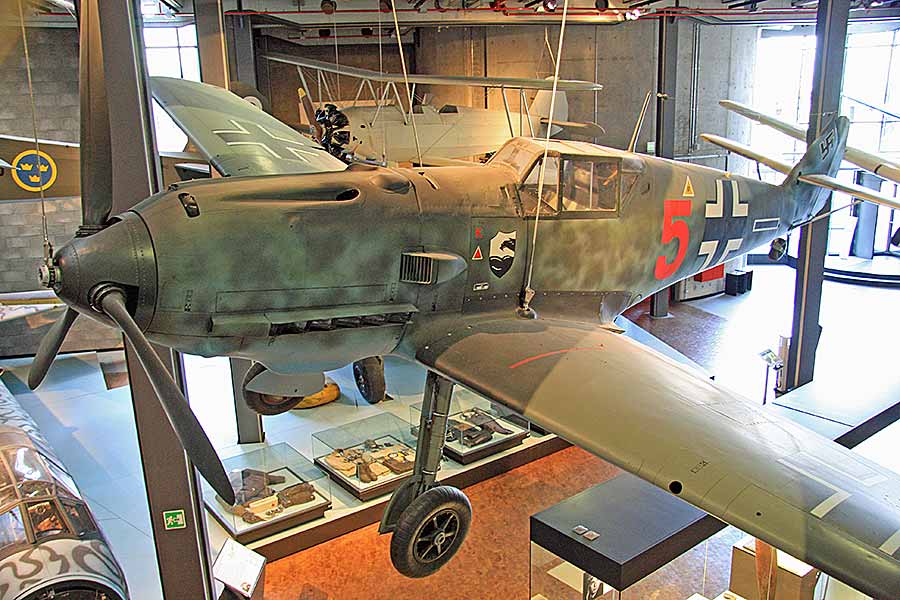
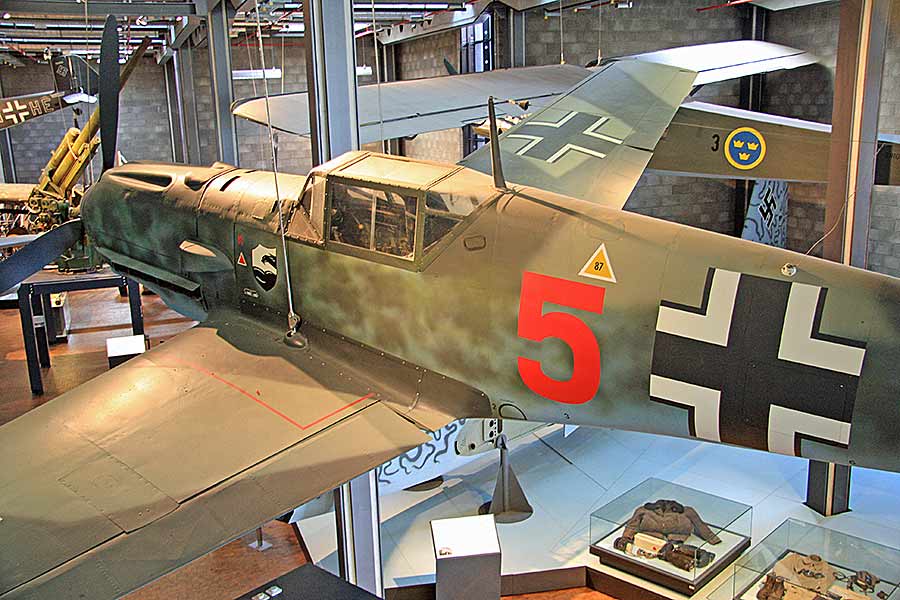
Messerschmitt Bf 109 E3 (1407)
[@ Deutsches Technik Museum, Berlin
By the time that conflict began in September 1939, 1060 Bf 109s of various sub-species were in service with the Luftwaffe's fighter units. These included the short-lived Bf 109 C "Caesar", powered by a 700 PS Jumo 210G engine with direct fuel injection, and the Bf 109 D "Dora". Developed from the V10 and V13 prototypes, the Dora was the standard version of the Bf 109 in service with the Luftwaffe during the period just before WW2. Despite this, the type saw only limited service during the war, as all of the 235 Doras still in service at the beginning of the Polish campaign were rapidly taken out of service and replaced by the Bf 109E "Emil", except for some night-fighter units where the variant was used into early 1940. Several Bf 109 Ds were sold to Hungary and Switzerland.
1407 was built as an E3 by Erla Maschinenwerke in Leipzig and
delivered to the Luftwaffe on the 28th November 1939. During
the 1940 Norway campaign 1407 served with 2./JG 77 and later on in the war 1407
was forced to land on a frozen lake close to Murmansk in the Kola peninsula.
When the ice melted 1407 sank to the bottom of the lake and remained there until
salvaged in 1993. During restoration a Red 5 mark was found on the
starboard side and a Black 2 mark on the port side indicating that 1407 had been
flown by more than one unit.
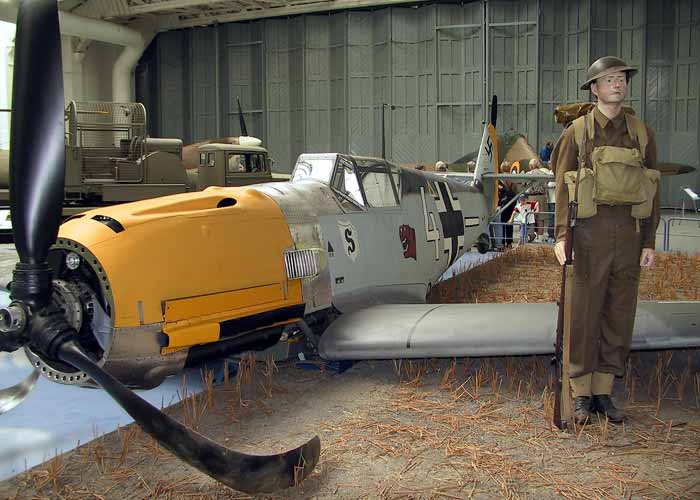
Messerschmitt Bf 109 E3 (1190) [@ RAF Duxford]
The Bf 109 E variant became the mainstay of the Luftwaffe's fighter units throughout 1940. Now powered by the V12 cylinder Daimler-Benz DB601 engine which was larger (35.7 litres as opposed to 27 litres) than the Merlin but its performance was similar to that of the Merlin due to the use of a more highly developed supercharging system by Rolls-Royce. This engine used direct fuel-injection control, which gave it better mixture control, although the Merlin carburettor system gave useful charge cooling and a slight power gain. Under negative g forces the fuel-injection proved most useful against the gravity carburettor Merlin (which would cut out). As a result the Bf 109s had the advantage in dives but the Spitfire was more manoeuvrable in turns (without height loss ~ 696 feet (212 m) in radius for the Spitfire and ~ 885 feet (270 m) for the Bf 109) at medium to high speeds than the Bf 109 due to the Bf 109's higher wing loading (32 pounds per square foot for the Bf 109 against 22 pounds per square foot for the Spitfire).
Werknummer 1190 actually took part in the Battles of France and Britain, shooting down five aircraft before suffering an engine failure and crash landing in a Sussex field on the 30th September 1940.
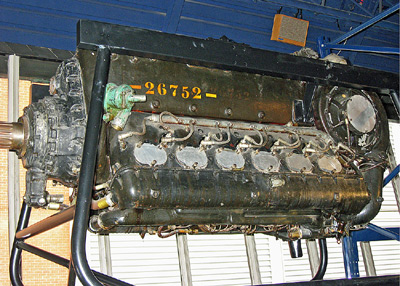
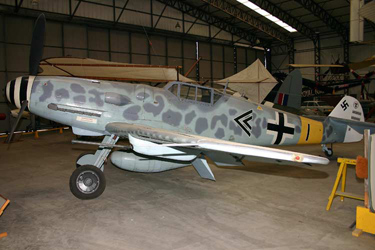 The series extended to the E9, including models built as
fighters, fighter-bombers and reconnaissance aircraft. Although a superb fighter
it, like most of its contemporaries, was under-gunned (a deficiency which was
not remedied until the introduction of the Bf 109 G) and had poor ground handling
characteristics. Perhaps its worst handicap, during the Battle of Britain, was
its limited fuel capacity. This meant limited range and endurance so, they could
only remain over the United Kingdom for a few minutes of combat before having to
break off the engagement and return to base. The Bf 109 E was as fast as the
Spitfire but not as manoeuvrable, faster than the
Hurricane and could out-climb
both.
RAF pilots who flew captured Bf 109s liked the engine and throttle response but
criticised the high speed handling characteristics, the poorer turning circle,
the greater force required on the control column at speed and the thick framing
of the cockpit glazing which they felt created blind-spots in the pilot's field
of vision.
The series extended to the E9, including models built as
fighters, fighter-bombers and reconnaissance aircraft. Although a superb fighter
it, like most of its contemporaries, was under-gunned (a deficiency which was
not remedied until the introduction of the Bf 109 G) and had poor ground handling
characteristics. Perhaps its worst handicap, during the Battle of Britain, was
its limited fuel capacity. This meant limited range and endurance so, they could
only remain over the United Kingdom for a few minutes of combat before having to
break off the engagement and return to base. The Bf 109 E was as fast as the
Spitfire but not as manoeuvrable, faster than the
Hurricane and could out-climb
both.
RAF pilots who flew captured Bf 109s liked the engine and throttle response but
criticised the high speed handling characteristics, the poorer turning circle,
the greater force required on the control column at speed and the thick framing
of the cockpit glazing which they felt created blind-spots in the pilot's field
of vision.
Ten Bf 109 Es were converted for operational testing from Germany's planned aircraft carrier, the Graf Zeppelin, under the designation Bf 109 T0 "Trägerflugzeug". The modification included adding a tail-hook, catapult fittings, structural strengthening, manually folding wings and an increased wingspan. Since the landing gear track was a little wider than the Seafire/Spitfire, it might have proven more reliable for carrier landings. With the tests completed an order for 70 T1s, powered by the DB601N engine, was placed. After 7 T1s were built the carrier project was cancelled and the remaining 63 T1 were converted T2 (no carrier equipment). These fighters were deployed in Norway and assigned to I/JG.77 who operated from short runways. In addition to the fighters the carrier was to have operated Ju 87 C dive bombers.
The Messerschmitt shown above at RAF Elvington (York Air Museum) is a replica of a 109 G6, flown by Major Anton Hackl of JG.11. The markings are of a Gruppenkommanduer of III Gruppe/JG.11. Anton Hackl was one of the most successful German fighter pilots of the WW2, with a final total of 192 victories (including 32 four-engined bombers) and a further 24 unconfirmed victories during his 1000 missions.
The best of all Bf 109 variants, the Bf 109 F "Friedrich" and powered by the Daimler-Benz DB601E engine, began to reach Luftwaffe units in France in May 1941 and was superior in most respects to the principal RAF fighter of the time, the Spitfire V. The Bf 109 F differed from the Bf 109 E in having a generally cleaned up airframe, redesigned engine cowling, wing, radiators and tail assembly.
It was proposed to join together two Bf 109 F airframes by means of a new wing and tail section. Designated the Bf 109Z "Zwilling" two variants were proposed, one being an interceptor armed with five 30 mm cannons and the other a fighter-bomber with a 1,000 kg bomb load. Only one Bf 109Z was built but it never flew since it was destroyed in a hanger by an Allied bombing raid.
The Bf 109 F was succeeded by the Bf 109 G "Gustav" (nicked named the "The Bulge"/"Die Beule" due to the notorious bulges in the cowling to allow for the additional cooling of the engine which appeared late in 1942. Pre-production Bf 109 G0 aircraft retained the DB 601E of the F series, but the first production model, the Bf 109 G1, had the new more powerful Daimler-Benz DB 605A engine (photograph - above). The promised higher speeds were obtained but manoeuvrability and handling were adversely affected. The G1, G3 and G5 had provision for pressurized cockpits and were fitted with the GM1 emergency power- boost system, which was lacking in the G2 and G4. Various armament combinations were employed and later aircraft were fitted with wooden tail units. The fastest G model, the Bf 109 G10, without wing armament and with MW 50 power- boost equipment, reached a maximum speed of 687 km/h (42 5 mph) at 7400m (24,278ft), climbed to 6100m (20,000ft) in six minutes and had an endurance of 55 minutes.
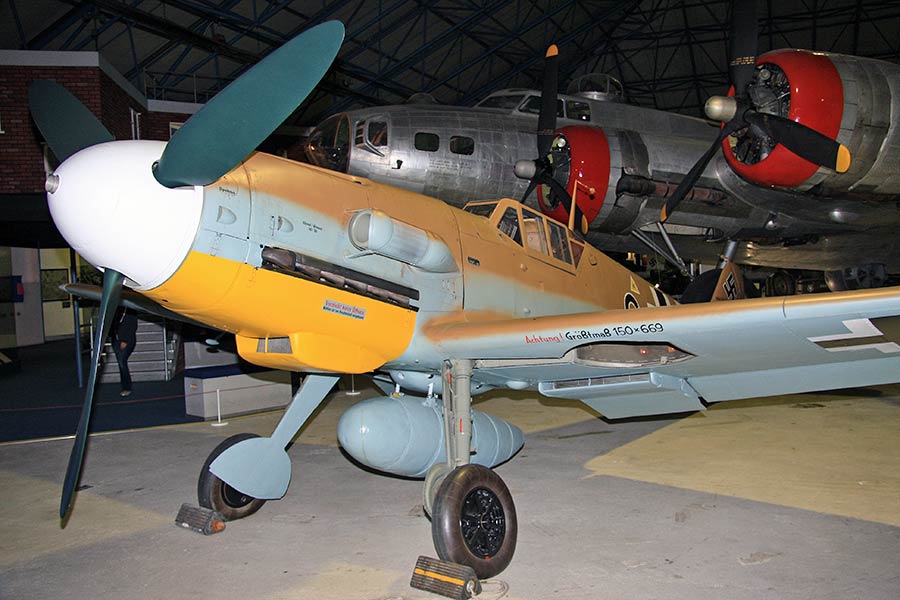
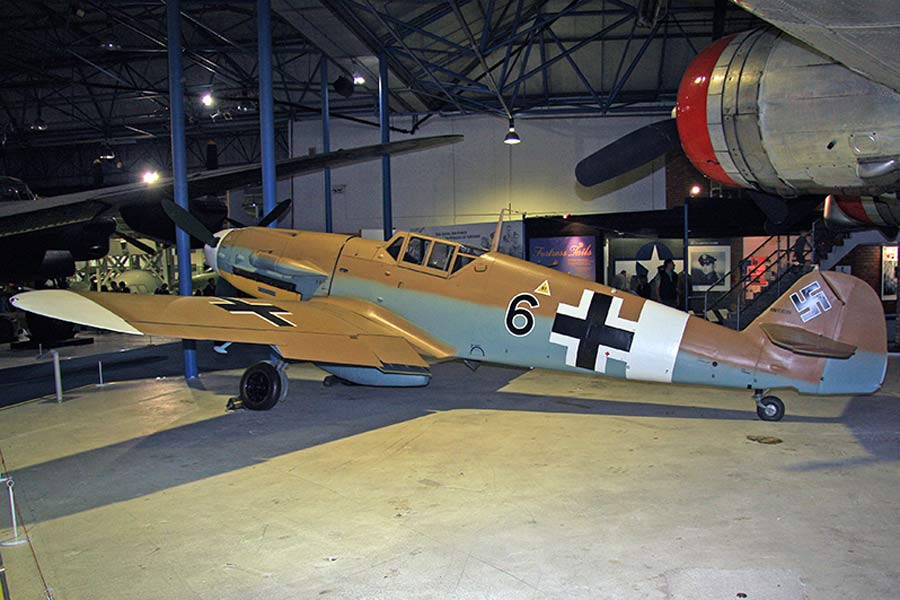
Messerschmitt Bf 109 G2 (10639/RN228) [@ RAF Hendon]
The Bf109 G series will be forever linked with the daylight bomber-killing missions in defence of the Reich. German fighter pilots found themselves facing heavily armed American B17 Fortress and B24 Liberator bombers and later long range P38 Lightning, P47 Thunderbolt and P51 Mustang fighters. Ground down by the overwhelming odds few survived the war.
Werknummer 10639 was built in Liepzig by Erla Maschinenwerk in September 1942 and served in the Desert War from 27th October 1942. However, shortly into its operational life it was found damaged and abandoned at Gambut, Tobruk, on the 13th November 1942 after about 10 hours of flying with damage to the tailwheel, tail plane, canopy and one propeller blade. Radio and oxygen equipment was unserviceable and some instruments were missing. The reflector sight and armament had also been removed, probably by the retreating Germans. On the 29th November 1942 209 (Fighter) Group RAF ordered that the aircraft should be officially flight tested as it one of the first G model 109s to be captured by the allies. Eventually shipped back to England on the 26th December 1943 for evaluation and testing as RN228. Now in RAF camouflage 10639 spent times with both 1426 Enemy Aircraft Flight at RAF Collyweston, Lincolnshire, and the Central Fighter Establishment at RAF Tangmere. Following the end of the war 10639 was stored for many years until a serious attempt of restoration started in September 1972. In 1987 the engine was refitted to the airframe following a rebuild by Rolls Royce at Bristol. Finally on the 17th March 1991, nearly twenty years later, 10639 flew again with the agreement that it would be flown for a limited period by the Imperial War Museum at Duxford before going on show at the RAF Museum. The second maiden flight was of 32 minutes duration at RAF Benson with Gp Capt Reg Hallam at the controls. Following a forced landing at the Duxford Autumn Air Show on 12th October 1997, 10639 was restored at Duxford and arrived at RAF Hendon on the 10th March 2002 by road.
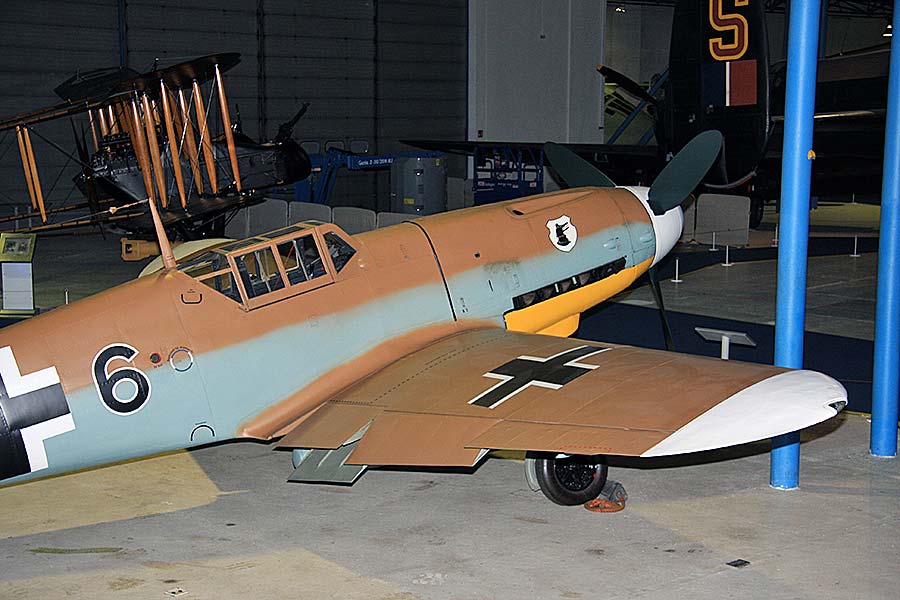
Messerschmitt Bf 109 G2 (10639) [@ RAF Hendon]
Developed from the Bf 109F series, the Bf 109 H was intended to be a high-altitude fighter. A small number of H1s were built and they were used in France. H2 and H5 developments were also planned but the entire H series was scrapped because of wing flutter problems.
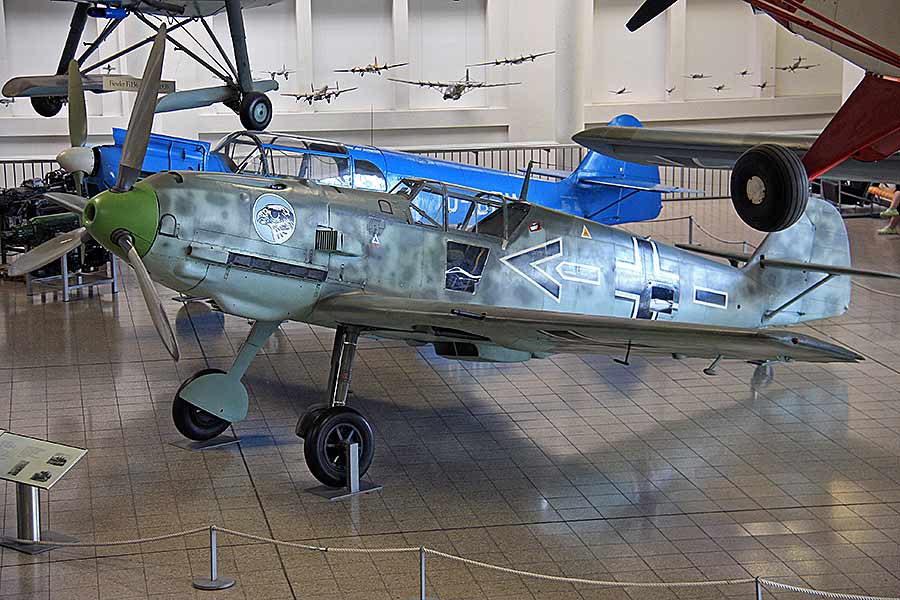
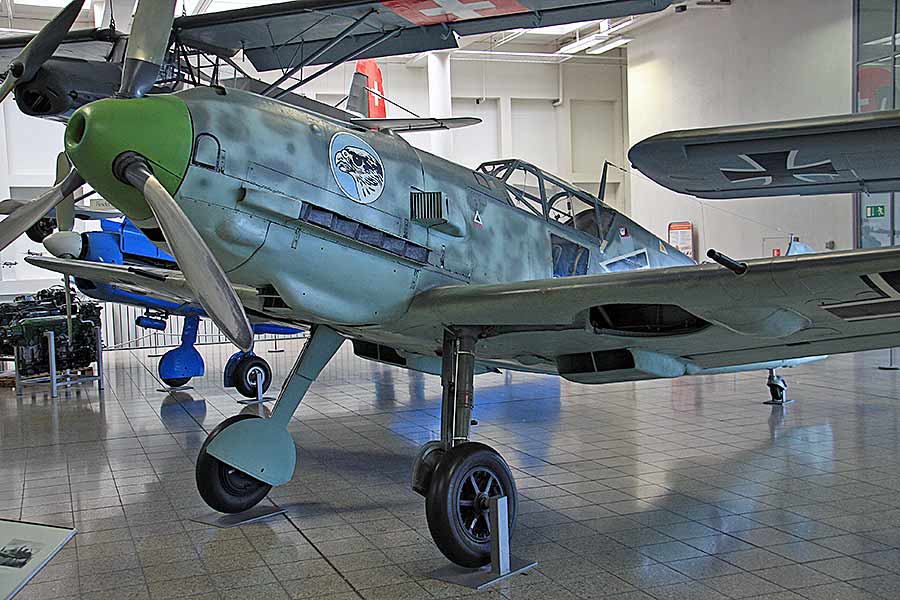
Messerschmitt Bf 109 E3 (0790) [@ Deutsches Museum, München]
Built by Erla Flugzeugwerk AG at Leipzig in 1938 as a Bf 109 E1, 0790 and was later modified to the E3 armament standard. 0790 could be oldest surviving Bf 109 and the only one of 44 Bf 109 E3s that served with the Condor Legion towards the end of the Spanish Civil War as 6-106. The Condor Legion was a unit composed of volunteers from the German Air Force and from the German Army which served with the Spanish Nationalists during the Spanish Civil War of July 1936 to March 1939. 0790 served with 2. Staffel of Jagdgruppe 88 (2. /J88) which was the first unit to fly the Bf 109 in the conflict having received three Messerschmitt Bf 109 prototypes in late 1936. These were soon followed by the first 15 of the latest Bf 109 B1s. Jagdgruppe 88 had formed on 3rd November 1936 as a German Condor Legion fighter group and consisted of four squadrons (Staffeln) although the 4th Staffel was short lived. The first major action of 2./J88 with the Bf 109 B1 took place during the Battle of Brunete in July 1937 when escorting Junkers Ju 52/3mg4e bombers. By utilising superior tactics developed by Lieutenant Werner Mölders of 3. /J88 the Bf 109s turned air superiority in favour of the Condor Legion. 0790 remained in Spain after the Civil War and was flown by the Spanish Air Force as C4E-106. Damaged during a forced landing 1946 0709 was transferred to the Lagrogno Technical School as an instructional airframe until 1954. At the request of Willy Messerschmitt 0709 entered the Deutsches Museum in 1960.
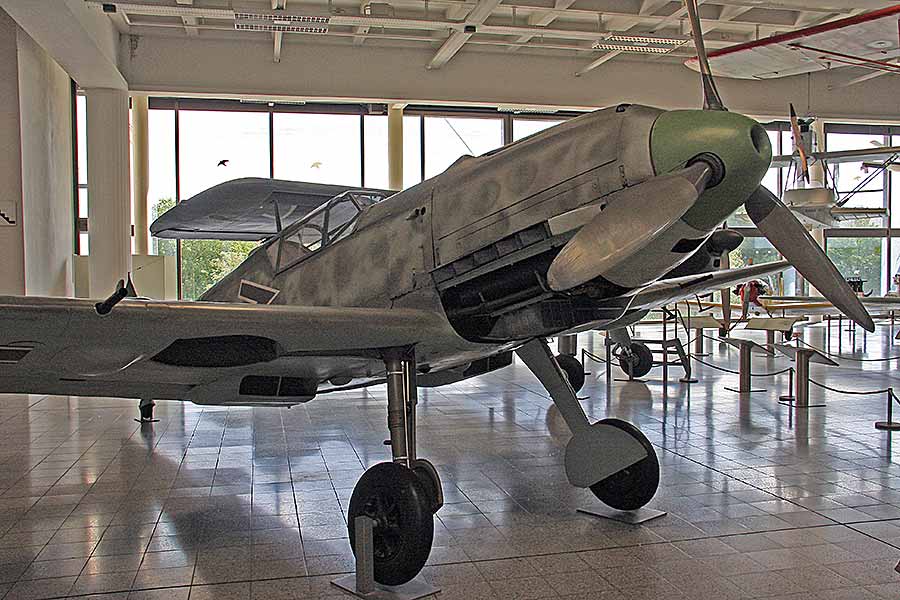
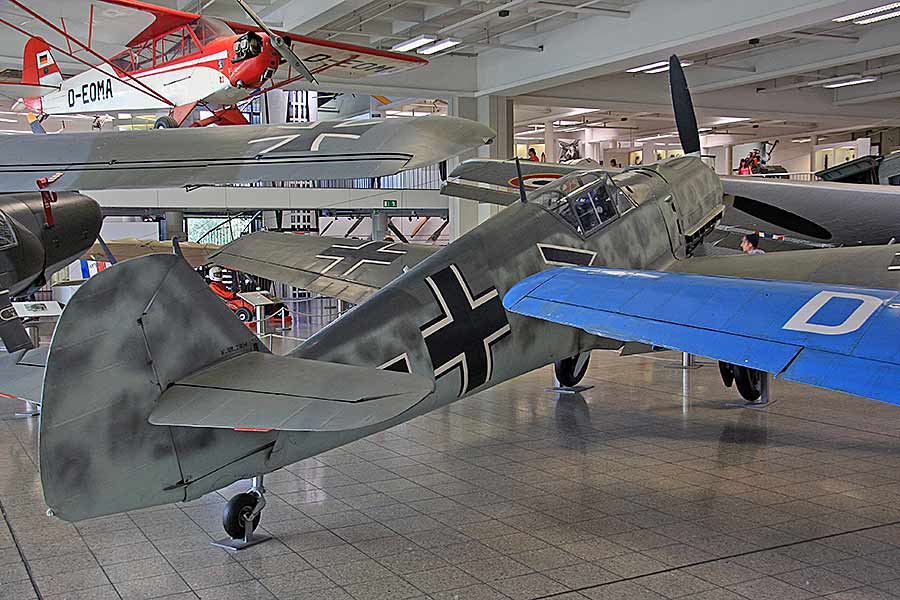
Messerschmitt Bf 109 E3 (0790) [@ Deutsches Museum, München]
The last operational versions were the Bf 109 K4 and Bf 109 K6, which both had DB 605D engines with MW 50 power boost. The Bf 109 K4 had two 15 mm (0.58 in) MG 151 guns semi-externally mounted above the engine cowling and a 20 mm (0.79 in) MK 108 or 30 mm (1.19in) Mk 103 firing through the propeller hub. The Bf 109 K6 had the cowling-mounted MG 151s replaced by 12.7 mm (0.50 in) MG 131 machine guns and had two 30 mm (1.19 in) MK 103 cannon in under wing gondolas. In fact most of the Bf 109 K "Kurfürst" series saw action during WW2. The operational service of the K series began in October 1944 but only the K4 saw action in large numbers, approximately 1,700 being delivered before the end of WW2. The K4 was the fastest Bf 109 of WW2 reaching 445 mph at 7,500 m altitude. The last variant was the Bf 109 K14, with a DB 605L engine, but only two examples saw service with JG 52.
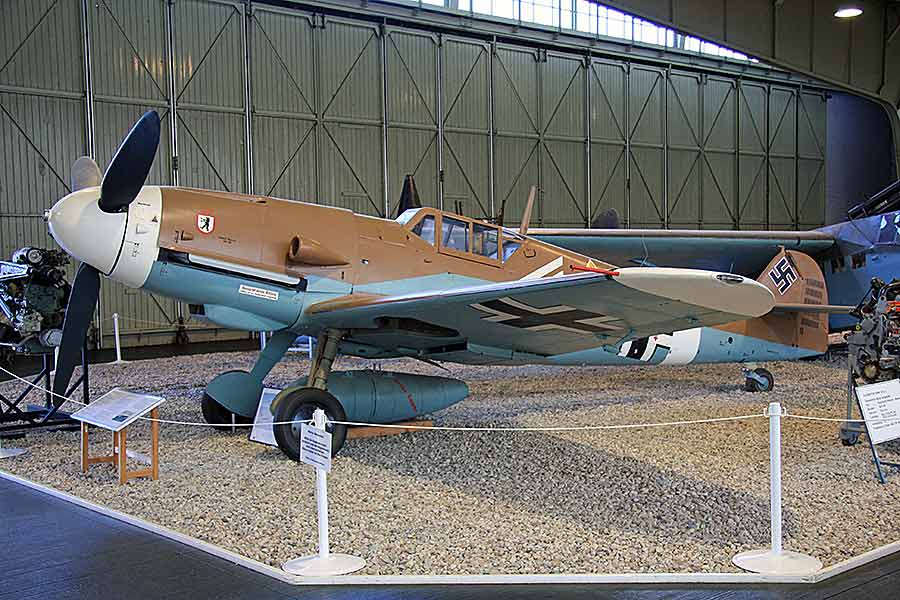
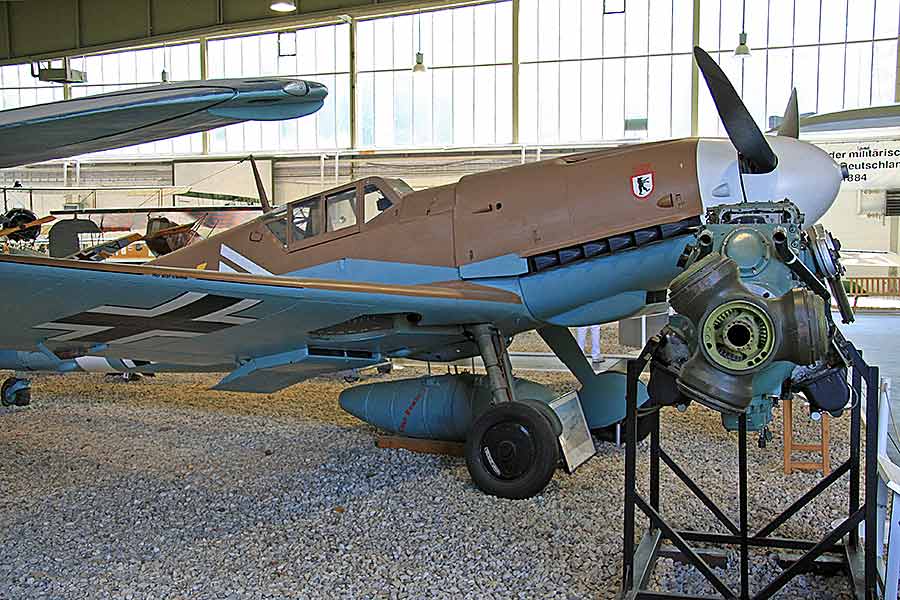
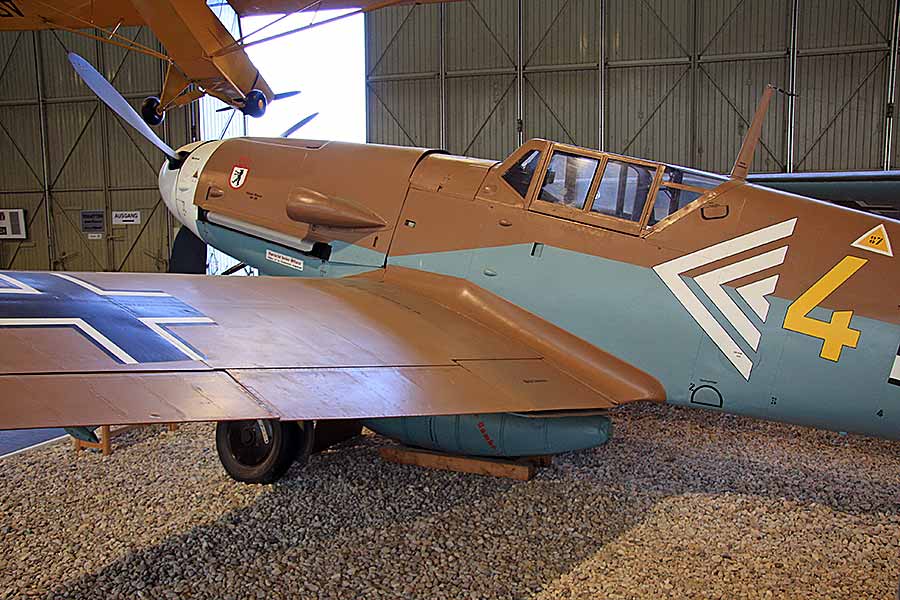
HA1109-K1L / Bf 109 G2 (10575) [@ Luftwaffenmuseum der Bundeswehr, Berlin]
In 1942 the Spanish government arranged with Messerschmitt to manufacture the Bf 109 G2 under licence using Germany supplied Daimler Benz DB 605A engines, propellers, instruments, and weapons. Due to the demands of WW2 Messerschmitt only supplied twenty five incomplete airframes. Hispano substituted the 1,300 hp Hispano-Suiza 12Z-89 engine for the Daimler Benz DB 605A engine and the aircraft flew for the first time at Barcelona in 1944. On the 2nd March 1945 the first HA-1109-J1L variant flew at Seville with the remaining twenty four following on. The variant was not flown operationally. From May 1951 the HA-1109-K1L and the HA-1112-K1L "Tripala" (65 built and used operationally) entered service. Fitted with a Hispano-Suiza 12Z-17 engine and a de Havilland propeller this variant was armed with two Hispano HS-404 20mm cannon and 80mm rockets. All of the original twenty five HA-1109-J1L variants were converted to this standard. Further variants followed with the final one being the HA-1112-M1L "Buchon". This variant (172 built) was fitted with a Rolls Royce Merlin engine, armed with two Hispano HS-404 20mm cannon and 80mm rockets and was used operationally.
10575 is an ex-Spanish HA1109-K1L variant which has been
restored with a Daimler Benz DB 605 engine to Bf 109 G2 standard. It is
displayed as Luftwaffe "10575 Yellow 4" of II Gruppe/JG27 that formed in January
1940 at Magdeburg.